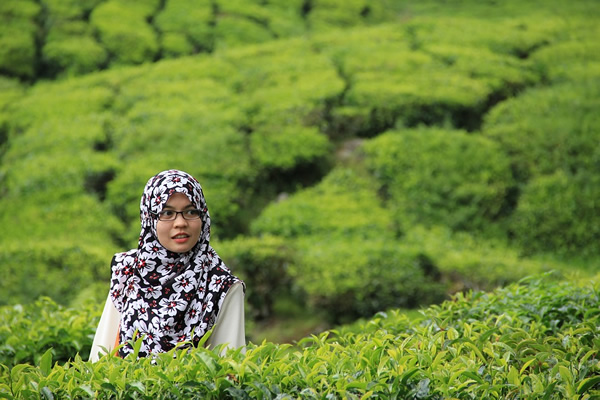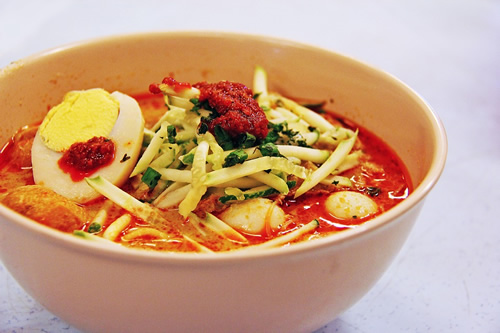Solo Woman Travel in Malaysia
by Nikki Maija Meyer

|
| Malaysia woman walking thtou a tea field. |
The train had just dropped me off in the northern Malaysia city of Butterworth, and I was waiting in the station for the night train south. Despite the fact that I had dutifully donned a voluminous scarf and long sleeves at the Thai-Malay border, the man sitting just behind me insisted on aiming sloppy kissing noises in my direction. I ignored him and pretended to watch the incomprehensible-to-me news flickering across the screen in front of me. When I abandoned my spot for a moment my persecutor poached my seat, ceased his heckling, and gazed adoringly at the television. Apparently it was my place he was after, and not so much an assignation out back behind the train station.
Many Western women traveling or living in a Muslim country find themselves bewildered, indignant, or just plain alarmed. Women who have worked hard for equal rights and treatment in their own countries can be reluctant to go to a place that might expect confining dress or restricted freedoms from them, but the adventurous who travel to Malaysia will be rewarded with the discovery of a fascinating culture and insights into their own.
By almost any standards, and particularly by Southeast Asian ones, travel in Malaysia is easy. Years of British colonial rule have made English widely, though not universally, spoken. Signs are in letters you’ll recognize, and useful words like “taksi” and “feri” have conveniently hopped right out of English and into Malay. Trains and buses are quick, cheap and comfortable. Don’t be dismayed by the conservative culture. Grab your scarf and go!

|
| Malaysian Laksa coconut dish. |
Malaysian women are anything but drab or dowdy. You’ll see them wearing elaborate colorful prints or immaculate business attire, with a head covering of lightweight fabric pinned at their throats. Johor Bahru, which is accustomed to the decadence of its neighbor Singapore, is inclined to be slightly more liberal. On some of the more informal islands, younger women might forego the headscarf or wear short sleeves. Women in shorts remain virtually unheard of. In most cities, I opted for a light cotton button-up shirt, trim nylon pants, and a flowered scarf that I tied at the nape of my neck to cover my hair.
As an outsider, your dress and behavior can serve as case-in-point for those who claim Westerners are selfish, loose, and immoral. Or you can do your best to adopt local norms and demonstrate that some foreigners can be courteous. Even though as obviously foreign you have an exempt status in Malaysia, why not redeem yourself by dressing modestly? Showing your respect for the sensibilities of the majority, so nobody can accuse you of Western debauchery, also demonstrates your support for Malaysian women working for change.
If giving up your right to dress as you please grates on you, it helps to keep in mind that in Malaysia your master status isn’t female, it’s not-Malay. You’ll have that in common not only with other Western travelers, but also Chinese and Indians who have lived in Malaysia for generations. Ethnic Malays are in a unique position in Malaysia. Until independence in 1963, Malays were mostly poor rural farmers. Chinese and Indian immigrants, in cahoots with the British, controlled business and industry. The Malays are still trying to gain economic footing in their own country, and in an attempt to right old wrongs, Malaysia politically favors Muslim religion and Malay language. This has created a fluid distinction between church and state, which means that many legal matters are settled in the religious court system (called the “shari’a”), or depending on how you look at it, that religious rulings can be legally binding.
In Malaysia, as in the United States, there are many pressures and conflicting expectations exerted on women. In working class families, women may take in sewing and contribute a lion’s share of the family’s income, but they often place their children’s and husband’s demands first and deny themselves sleep to finish their piecework. Women are technically eligible for many jobs, but may be excluded by creative measures, such as the advertisement I saw for an immigration officer specifying that they must be able to lift 50 kilograms. (In all my travels, I’ve yet to see a date stamp that weighed 50 kilos.) Organizations can find funding and public support to shelter and treat abused women, but are shunned as home-breakers when they try to educate women about how to leave their abusive husbands.
Life for Malaysian women, and women traveling in Malaysia, can be ringed at the edges with injustice. But that’s no reason not to go. What American woman can’t sympathize with the demands on a woman trying to do it all at work and at home; has never met someone who’s bumped their head on the glass ceiling; hasn’t heard whispers about a friend’s husband or a niece’s boyfriend?
Around the corner from my apartment in New Hampshire is an old brick house. The dense oak doors are always shut, the curtains battened down. One morning as I approached the brick house, I heard the snap of the big fraternity flag over the porch, swelling and flapping in the wind. Three young men were perched on the steps of the porch, surveying the scene in the alley at their feet. I picked up my pace. I had nearly passed them when I heard shouts.
“Sweetheart! Where you going, huh? Hey, sweetheart!”
|
For More Info
Lonely Planet Malaysia is a fine general site and Lonely Planet also has a guidebook on Malaysia and nearby Singapore and Brunei.
Destinations
Penang: island city with a diverse cultural mix. A few less-than-stellar beaches, but lots of narrow alleys and street-side shops to explore. Wander in the Indian district and buy samosas and orange sesame sweets to eat as you go.
Johor Bahru: the tip of the iceberg at the end of the Malaysian peninsula, just across the much disputed causeway from Singapore. Navigate the noisy but comprehensive bus system to visit shopping centers all over the city.
Visit the village of Juara on Pulau Tioman. To get to this tiny, un-touristed village, fly from Singapore’s secondary airport; take a bus to Mersing on the east coast and the ferry to Tekek. Then, hike four miles over the steep path, which is well sign-posted, or hire a 4-wheel drive vehicle to deliver you (low cost split between however many passengers you can squeeze in.) While there snorkel with the colorful sea life at the south end of the beach. Visit the sea turtle hatchery on the north end of the beach. Play badminton with the village kids and enjoy life at Pulau pace. Rent a kayak from any of the several village resorts and paddle around the big boulders standing sentinel in the north end of the bay. Visit the waterfall, a 30-minute obscurely marked walk.
Eat roti canai from Ali Putra or Hamdaan Café, both immediately opposite the end of the bush trail from Tekek. Don’t eat endangered sea turtle eggs. Even if the locals say they’ll make you virile.
|
Nikki Meyer now shares a yurt in Montana with her husband and their charming cats. When she’s not traveling, she spends her time hiking in the Rockies, homebrewing beer, and attempting to re-create her favorite Thai, Malaysian, and Indian recipes.
|
